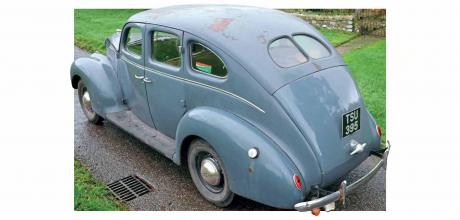1938 Ford Model 81A Deluxe
1938 Ford V8 Deluxe Sedan Don’t judge this book by its cover because it’s as solid, powerful and practical a car as anyone could own for relatively little money and is still going strong today, as Zack Stiling discovered… Words and photography: Zack Stiling.
OLD RELIABLE
Like many car collectors, Edwin Phelps manages to contain a surprising number of treasures in what, to the outside world, seems a perfectly innocuous outbuilding. And, as with some collections, many of those treasures are not quite on the road just now, they will be one day. The theme of Edwin’s collection is early Ford V8s and, while his attention is divided between his various projects, there is at least one faithful, trusty old car which Edwin knows will take him wherever he needs to go.
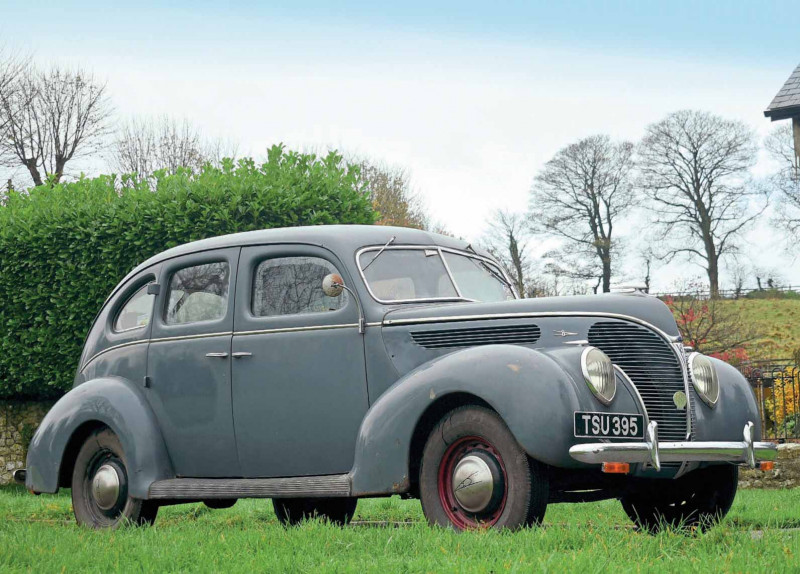
The 1938 Ford Model 81A Deluxe four-door sedan has been in his possession since 1998, with a brief interval from 2004 to 2006. Edwin has a peculiar knack for finding rather exotic Fords – others in his collection came from Uruguay and the former Rhodesia – and the ’38 is no exception. The right-hand drive would probably lead most to assume it was made in Dagenham, but in fact it’s a South African car, shipped as a knock-down kit from Canada and assembled at Ford’s plant in Port Elizabeth. Two important details give away its African origins. The glass is by Shatterprufe, a South African company, and the headlining is faux leather, whereas in other markets it was fabric.
Growing up on the family farm in Somerset’s Mendip Hills, the Phelps passion for V8 Fords was sparked by an old rodding magazine and an off-the-cuff remark Edwin’s father made. “When I was about 14 or 15, I had a copy of Hot Rod or something similar,” Edwin explains. “My father was looking at it and there was a ’36 phaeton. He said: ‘I used to have one like that, with an English coachbuilt body, and it would go up the hill in top gear,’ so I thought: ‘I ought to get one of those!’” For readers not familiar with Mendips topography, some of the hills are very steep indeed; a top-gear ascent is no mean feat.
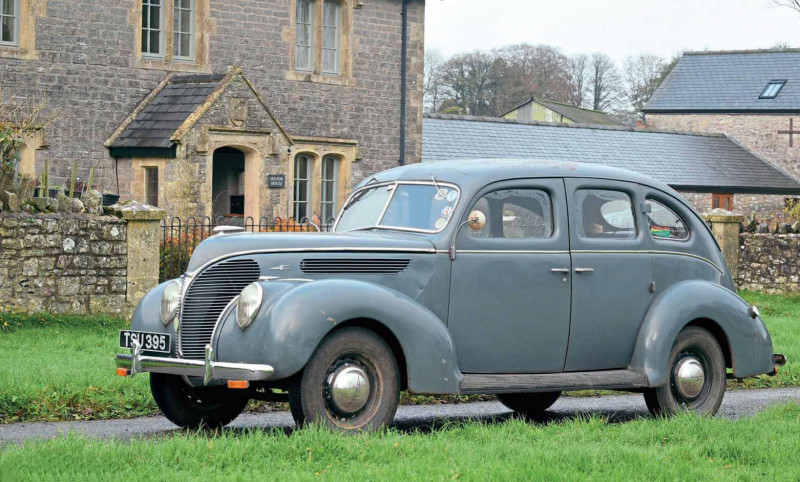
Edwin acquired his first flathead Ford in 1973, a Pilot he bought for £40 with a dismantled engine. Fitting a lorry engine he found in a scrapyard, he got it running but ultimately sold it for £100. However, he returned to V8 ownership in 1987 with a Model 62 and since then has been gradually accumulating, driving and restoring an interesting assortment of Thirties Fords.
Although he didn’t buy it until 1998, Edwin first saw the ’38 in 1993. It had only arrived in Britain in 1990, when it was sold by Parkfield Motors of Cape Town for 16,500 rand to C B Smith of Essex. In 1993, it was sold through an auction at Winkleigh Airfield in Devon, where Edwin let it pass by, but it ended up in the famed John Mould Collection, alongside other early Ford V8s and desirable vehicles of all kinds. When Mould was thinning out his collection, as he does periodically, by way of an auction in October 1998, Edwin stumbled across it again. As he had a slightly ropey Model B saloon at the time, he says: “I went to the auction with the intention of buying a better one, but it went for too much money so I thought I’d have a go at getting the ’38 and I won it.”
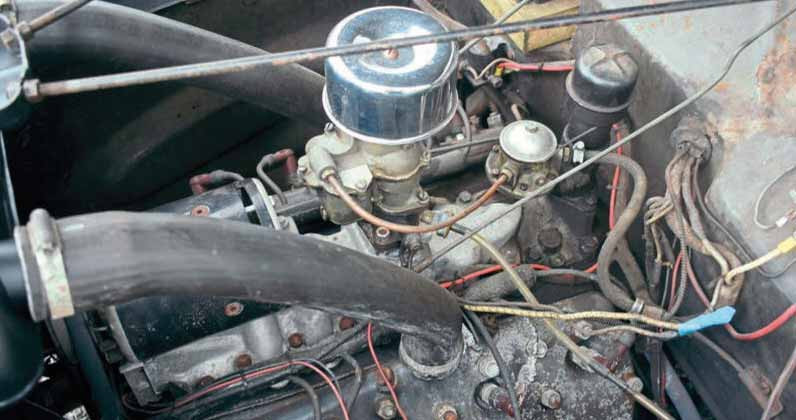
Since then, it has been highly agreeable, asking for very little. When Edwin bought it, it needed a new battery, steering drag link, kingpins, and split-pins in virtually every castellated nut. As it had an incorrect 1939 speedometer, he fitted a new old-stock 1938 item he found at the NEC in 2001. Otherwise, he has hardly had to touch it, despite covering 35,000 miles driving to events all over the country. The only major undertakings have been an engine rebuild sometime around 2011 by flathead specialist Jim Turnbull of Royal Kustoms (see www.royalkustoms.co.uk) and a gearbox rebuild in 2016 which Edwin completed himself. The two-year interim when the Ford was owned by Barry Winn of Pensilva, Cornwall, was not occasioned by Edwin falling out of love with the car, but because he sympathised with Winn’s desire to own a ’38 sedan like the one his father had when he was a boy.
“It had some strange Sixties air filter I didn’t recognise,” Edwin adds, so it now has a generic but more appropriate replacement. Keen-eyed readers will also have spotted the odd wheel, which Edwin had to fit when he discovered the original was slightly distorted.
The attractively weathered paint is not, as may be assumed, the original coat, but one which was applied in South Africa, probably to tart it up for its sale. The original Wren Tan paint is visible where some of the grey has flaked off. It would have been for the same reason that the interior was partially reupholstered, although the seat backs, door cards, headlining and rear seat squabs are original and in lovely condition. While it may not have pleased its new English owner to know of the somewhat slapdash nature of its paint job, that and the gentle weathering effects of the British climate have combined to cultivate a delightful patina.
Of course, the most interesting attribute of Edwin’s car is its South African provenance. A 1903 Ford Model A is recorded as being the first Ford in South Africa and reputedly also the first Ford sold outside America, and Arkell & Douglas of Port Elizabeth became the country’s first official Ford agent in 1905.
It wasn’t long before agents started springing up everywhere. The Model T conquered South Africa much as it conquered everywhere else and, in July 1923, two importers, H G Holmes and H F A Stockelbach, visited Ford’s Canadian factory to discuss a South African assembly plant, and the Ford Motor Company of Southern Africa was established. Then in February 1924 a former wool store in Port Elizabeth was turned over to Model T production. This was subsequently replaced in 1930 by a purpose-built factory and the rest, as they say, is history, Perana Capris and all.
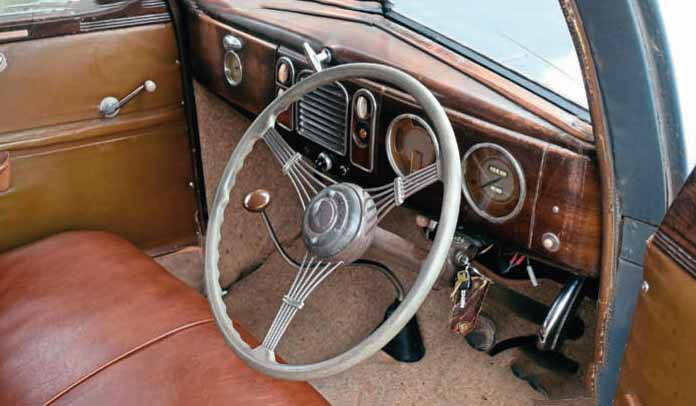
Even in America, the 1938 Deluxe is a relatively rare model as it has regrettably come to be considered an ‘ugly duckling’, and its styling has not made it a collector’s favourite. The Standard model was not received so badly as its front-end sheet-metal was little changed from the 1937 models, but Ford’s assertion that the restyled Deluxe model was the most beautiful Ford yet produced was not a sentiment the buying public shared. Consequently, sales for 1938 were less than half what they had been in 1937 and amounted to Ford’s least successful year since 1933.
One should not judge a book by its cover, though, and appearances do not change the fact that the ’38, like all Fords, was as solid, powerful and practical a car as anyone could expect to own for relatively little money. If the styling did not entice people towards the Deluxe, the engine may have done – where the Standard relied on a super-economy 60bhp V8, the Deluxe boasted the popular and potent 85bhp, 221cu in V8 developed from the original 1932 unit.
In America, that sort of thing would be taken for granted. In South Africa, its sturdiness would be considered quite necessary for crossing the more rugged parts of the country. Over here, it is simply a phenomenally good car. With a reassuring, but not intrusive burble, Edwin’s Ford appears not to even notice the formidable hills which would have a contemporary Austin 10 puffing away furiously in first. The three-speed crash gearbox is quite straightforward, not that Edwin has to use it much, as, like most American cars of the period, it has a huge reserve of bottom-end torque. The cable brakes are dated – Henry Ford stubbornly professed his faith in ‘the safety of steel from pedal to wheel’ while other manufacturers moved to hydraulics – but perfectly efficient.
Since the Mendips’ remote roads are typically one-car wide and full of blind corners, one might wonder if the Ford’s size and heaviness make it rather impractical, but it would seem not. Though undoubtedly large by British standards, it has none of the excess bulk of post-war American cars and probably occupies less space than the typical modern SUV. The only inconvenience of ownership is the rear-hinged bonnet with fixed sides, which makes engine access extremely difficult.
The fact that the car has needed minimal maintenance in spite of the thousands of miles it has covered is testament to the enduring reliability of Ford engineering. From Somerset, Edwin has taken it many times to the Rally of the Giants, Abingdon All-Ford Rally, Enfield Pageant of Motoring and the Old Ford Rally at Gaydon. So, if you haven’t seen it traversing the Queen’s highways on its way to one show or another yet, you probably will one day – it’s not showing any signs of stopping.
Rear-hinged back doors. Edwin’s Ford dream became a reality. Ford displays almost ‘fastback’ styling. Orange turn signals are a concession to modern driving. Engine is a 85bhp, 221cu in flathead V8. Above: Ford offered Standard and Deluxe models for 1938 and our feature car was assembled in Ford’s South African Port Elizabeth factory. Right: Art Deco styling and bakelite abound inside. Left: Original Wren Tan colour is now covered in grey paint. Banjo-style steering wheel is a 30s classic.


